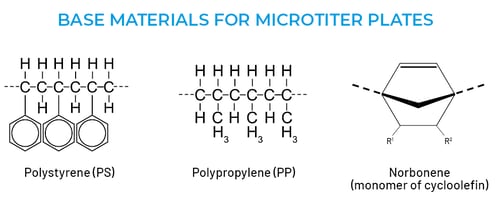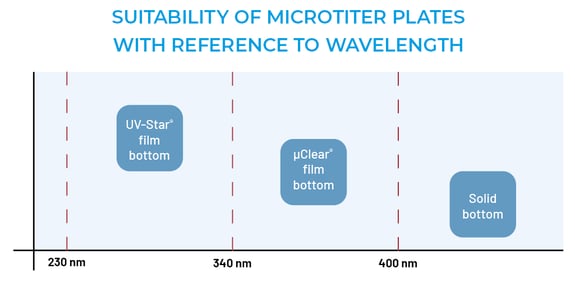Optimizing HTS Microtiter Plate Selection with our Product Finder
This article introduces the Greiner Bio-One product selector to help you select the right microtiter plate for your high-throughput screening campaign. We discuss microtiter plate selection and recommended practices in high-throughput screening and quantitative biology.
Go directly to the Product Finder:
Microtiter plates by application: Tell me your technology and I’ll tell you what you need
The surface properties of screening microtiter plates must be adapted to the research question at hand. For example, protein adsorption on microtiter plates increases in the following order:
non-binding polystyrene > polypropylene > untreated polystyrene > high-binding polystyrene[1]
Surface and bottom considerations for biochemical screening
Polystyrene (untreated)
Polystyrene microplates without surface treatment are characterized by low binding of biomolecules and are often used for biochemical screening applications.
Polypropylene (untreated)
Polypropylene microtiter plates are used for storage applications and biochemical assays. They show lower biomolecule adsorption than polystyrene microtiter plates.
Polystyrene (non-binding)
Non-binding polystyrene microtiter plates are particularly suitable for sensitive biochemical assays. Since molecules such as proteins, peptides and nucleic acids are bound to a very low extent, these plates achieve high assay sensitivity and improved signal-to-noise ratio.
Polystyrene (medium-binding)
Medium-binding polystyrene microtiter plates are suitable for heterogeneous / immunological assays such as ELISA, FIA and LIA. The incoming raw material used for ELISA microplates is routinely monitored for identity and immunological quality to ensure a stable coefficient of variation (CV) from batch to batch.
Polystyrene (high-binding)
High-binding polystyrene microtiter plates are also suitable for heterogeneous / immunological assays. In comparison to medium-binding plates those plates possess a higher binding capacity.
Polystyrene (streptavidin-coated)
Streptavidin is a useful tool for many molecular biology applications. The very tight bond between streptavidin and biotin can be utilized to attach biotin-labeled proteins, nucleic acids, or other compounds to the streptavidin-coated microplate.

Due to the high clarity of polystyrene, plates made of this material are ideal for colorimetric measurements in the visible range. It should be noted that the transmittance of polystyrene products decreases sharply at approximately 400 nm.
When a lower wavelength range is needed, Greiner Bio-One offers thin transparent film bottoms in black or white framed µClear® plates. These enable detection capabilities down to 340 nm and are also ideally suited for standard microscopic applications. For measurements in the lower UV range, which is used, for example, for DNA or protein concentrations, there are UV-Star® microplates made of cycloolefin with transmission down to 230 nm.
Greiner Bio-One product finder
The success of high-throughput screening can be significantly influenced by the careful selection of microtiter plates and the application of best practices. One must keep in mind that microtiter plate surfaces are not uniform and can significantly affect the results of the assay. Key parameters such as the number of wells, microtiter plate color, well volume, well shape, and microtiter plate surface coating are of particular importance. Experiments including incubation and dosage of substances and reagents should also be carefully optimized.
Choose the right high-throughput screening microtiter plate for your application with our product finder:
References
[1] Greiner Bio-One Microplate Selection Guide https://www.gbo.com/fileadmin/media/GBO-International/01_Downloads_BioScience/SALES_Brochures/English/F073048_microtiter plate _Selection_Guide_EN.pdf


